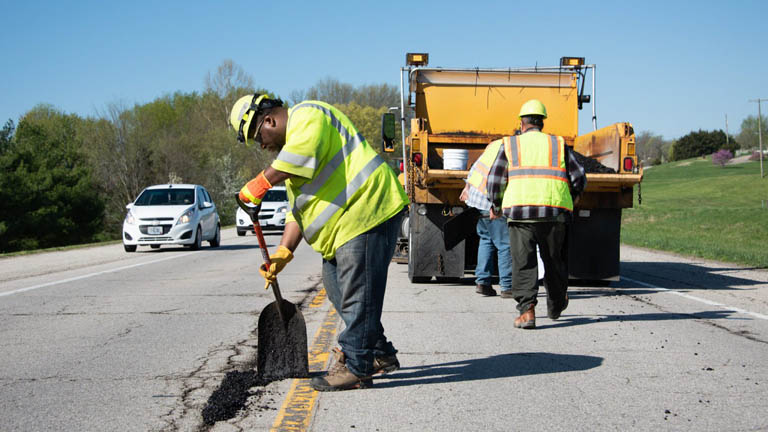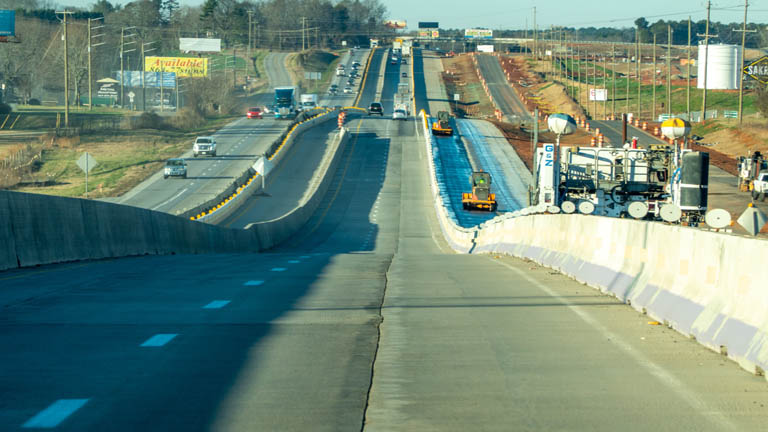April 23, 2025
A successful collaboration between Mizzou and MoDOT helps travelers, truckers and construction workers stay safe year-round.

At Mizzou Engineering, each of our pursuits has a bigger purpose. Frequently, that means applying research to improve the lives and safety of people across Missouri and beyond.
One such pursuit is the Missouri Work Zone Safety Center of Excellence (MOWZES), a collaboration between Mizzou and the Missouri Department of Transportation (MoDOT) that seeks to achieve zero fatalities and serious injuries in work zones.
“Our research addresses the safety of everyone who uses Missouri roads,” Praveen Edara, professor and chair in the Department of Civil and Environmental Engineering, said. “That’s passenger and commercial vehicles on the one hand and pedestrians, people with disabilities and bicyclists on the other.”
“This is another example of how Mizzou Engineering adds value to Missouri,” Ed Hassinger, director of MoDOT, said. “We’re very fortunate to have them as a partner. Together we are working to make it safer for those who are working on the roads and for the motorists that are driving them.”

As summer travelers join the regular commuters and truckers on Missouri roads, MOWZES researchers are working on several research and education projects that identify and implement solutions that transform work zone safety. Here are a few.
Accurate Collection and Reporting of Worker Presence in Work Zones
Principal investigator: Zhu Qing
Sponsor: MoDOT
The project will assess current technologies — such as radio frequency identification, GPS, Bluetooth and ultra-wideband — for their suitability in highway environments, focusing on factors like accuracy, power use and integration with existing systems.
“We want to reduce work zone crashes, improve emergency response and streamline resource coordination for construction operations,” Qing said.
Through field testing and implementation studies, the team will validate these technologies under real-world conditions and develop tools to seamlessly integrate worker presence data into safety reporting and project management systems.
Effective Coordination with Towing Companies for Incident Response and Clearance
Principal investigator: Henry Brown
Sponsor: MoDOT
The project focuses on improving towing safety, particularly in reducing secondary crashes and protecting tow truck operators who work in high-traffic areas.
“We want to improve the speed and safety of clearing incidents on Missouri roads, enhance safety and reduce crashes,” Brown said.
The project aims to develop training materials for towing safety and improve towing practices. MoDOT is particularly interested in learning about successful strategies other states have implemented to enhance safety.
Integrating Virtual Reality into Multiple Work Zone Training Programs
Principal investigator: Praveen Edara
Sponsor: Federal Highway Administration
This project addresses the need for more effective training practices by leveraging virtual reality (VR) technologies to create an immersive and engaging learning environment for work zone practitioners.
“Well-trained personnel and supervisors are essential for improving the safety of both workers and motorists in work zones,” Edara said.
Initial results indicate that the VR modules not only enhance trainees’ ability to identify deficiencies but also improve instructors’ ability to assess trainee performance.
Multibody Dynamics Modeling of TMA Truck and Driver Safety Systems
Principal investigator: Praveen Edara
Sponsor: MoDOT
This research project evaluates the effectiveness of in-vehicle safety countermeasures designed to protect drivers of truck-mounted attenuators (TMAs, or road barrier trucks) in work zones.
“Given the high frequency of rear-end collisions involving TMAs — often resulting in head and neck injuries — we focused on three safety features: active headrests, reactive seatbacks, and anti-whiplash systems,” Edara said.
Results showed that an active headrest with 40-mm displacement significantly reduced injury risks across all tested conditions, while the reactive seatback and anti-whiplash systems provided limited benefits, especially under high-impact collisions.
Preparing Local Governments for Automated Driving Systems – Implementing work zone data exchange in St. Charles County, Missouri
Principal investigator: Yaw Adu-Gyamfi
Sponsor: Federal Highway Administration
Each state collects different work zone data based on their priorities, and the information is often not updated frequently or made available to vehicles in real time. This creates inconsistencies and gaps that hinder the ability of connected and automated vehicles to navigate work zones safely.
“Our goal was to develop a framework for collecting, integrating, standardizing and sharing work zone activity information with vehicles across states in a connected and automated environment,” Adu-Gyamfi said.
Mizzou researchers developed a mobile and web application to collect work zone data including work type, worker presence, and start and end of work zone. The resulting data feed is pushed in real time in a format that can be integrated into vehicle navigation and safety systems.

Real-life lessons
Recently, engineers from MoDOT and contractors have addressed Mizzou student seminars about the Improve I-70 projects, which will repair and expand Interstate 70 from Blue Springs to Wentzville.
Dave Simmons, design-build coordinator for MoDOT, spoke about accelerating construction schedules and shortening construction durations by using the design-build delivery method, in which a single contracting team is hired to both complete the design work and build the highway improvement.
Joshua Scott, transportation project designer for MoDOT, spoke about using design-build to improve safety for all users, including pedestrians, in downtown Kansas City.
Joshua Doerhoff, executive vice president of Emery Sapp and Sons, discussed how his company bid for and won the contract for Improve I-70 Project 2 (Warrenton to Wentzville).
Jeff Gander, central project team director for MoDOT, presented the Improve I-70 schedule and several highlights of Project 1 (Columbia to Kingdom City), including the US 63 and US 54 interchanges.
Improve the lives and safety of people across Missouri and beyond. Choose Mizzou Engineering!